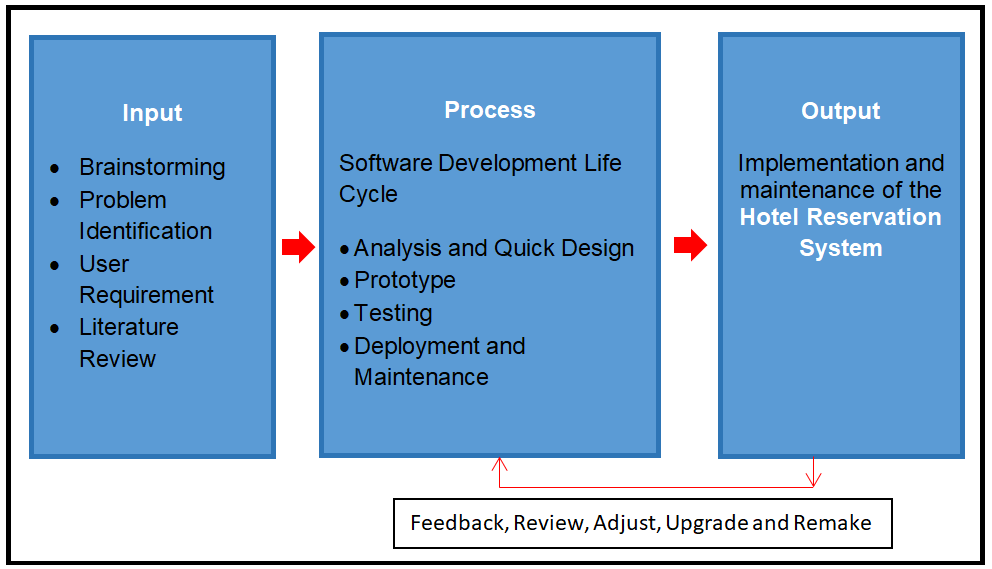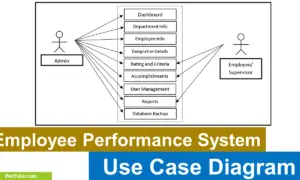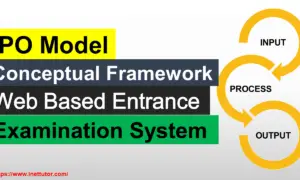Hotel Reservation System Conceptual Framework
This article will show you how to create a Hotel Reservation System conceptual framework. The Conceptual Framework is based on IPO model.
About the Project
Table of Contents
Hotels need guests in order for their business to succeed. In a conventional way, the guests personally visit the hotel they wish to stay in to book rooms. This method is time-consuming and requires too much effort from the guest. The capstone project, “Mobile App Hotel Reservation with SMS Notification using iTexMo API” is a mobile-based application that allows hotel guests to make reservations in the hotel. The application will be used by the guests to schedule the dates and length of their stay in the hotel.
A conceptual framework for a hotel reservation system typically includes several key components, including:
User interface: This is the way that customers interact with the system, typically through a website or mobile app.
Database: This is where information about available rooms, prices, and reservations is stored.
Reservation system: This is the core component of the system, responsible for managing and processing reservations.
Payment processing: This component handles the financial transactions associated with reservations, such as charging credit cards or processing refunds.
Communication: This component allows the system to communicate with customers, such as sending confirmation emails or text messages.
Reporting and analytics: This component provides information about the performance of the system, such as occupancy rates and revenue.
Administration: This component allows hotel staff to manage the system, such as updating room availability or processing refunds.
Overall, the conceptual framework of a hotel reservation system should be designed to make it easy for customers to find and book available rooms, while also providing hotel staff with the tools they need to manage reservations and optimize the performance of the system.
Objectives of the Study
- To develop a system that will automate hotel reservations.
- The system will let the hotel guest make reservations of rooms for their stay in the hotel electronically.
- The system will let hotel businesses reach a huge number of guests by providing a convenient method for bookings.
- The system will provide a fast, accurate, and hassle-free manner transaction.
- The system is efficient and reliable to use.
Conceptual Framework Diagram

The accompanying diagram depicts the conceptual framework for the project Hotel Reservation System. It’s based on the IPO (input, process, and output) model.
What is a Conceptual Framework?
The IPO model helps to identify the key components of a system and how they are related to one another. It is useful for understanding the flow of information and activities within a system and for identifying potential areas for improvement. It is widely used in various fields like business process management, software development, and project management.
A conceptual framework is a blueprint that outlines the structure and components of a system. In the context of a hotel reservation system, a conceptual framework is essential for the development of an efficient and user-friendly system.
The purpose of a conceptual framework in the development of a hotel reservation system is to provide a clear understanding of the system’s components and how they interact with one another. It outlines the key elements of the system, such as the user interface, database, reservation system, payment processing, communication, reporting and analytics, and administration. By understanding these components, developers can ensure that the system is designed to meet the needs of both customers and hotel staff.
A well-designed conceptual framework is also important for the optimization of the system’s performance. By identifying the inputs, processes, and outputs of the system, developers can identify areas for improvement and make sure that the system is operating as efficiently as possible.
Additionally, a conceptual framework also helps in creating a system that is easy to use and understand for the end-users. It ensures that the user interface is intuitive, and the system’s functions and features are easy to access.
In conclusion, a conceptual framework is an essential tool for the development of a hotel reservation system, it helps to ensure that the system is designed to meet the needs of all stakeholders, is efficient, and easy to use. By using a conceptual framework, developers can create a hotel reservation system that is designed to meet the needs of customers and hotel staff, while also optimizing the system’s performance.
Input
The project will begin by evaluating the present process, which will lead to the stage of determining the users’ needs, also known as the user requirement stage. The researchers will also need to compile relevant papers and systems to use as a guide for the project’s development.
Process
The researchers will select and choose the optimum software development life cycle model for the project in this section.
Analysis and quick design, prototyping, testing, deployment, and maintenance are all part of the process.

Output
The project comes to life and is executed in the real world after all of the necessary procedures have been completed. A new project is born, and it will be maintained for the project’s long-term survival.
The possible outcomes of a hotel reservation system can include:
- Customer satisfaction: Customers are able to easily find and book available rooms and their reservations are processed accurately and efficiently.
- Increased revenue: The system is able to effectively manage and optimize room availability, leading to increased occupancy rates and revenue for the hotel.
- Improved efficiency: The system automates many tasks, such as processing payments and sending confirmation emails, reducing the workload for hotel staff and increasing efficiency.
- Enhanced communication: The system allows for easy communication between customers and hotel staff, such as through the sending of confirmation emails and text messages.
- Better reporting and analytics: The system provides detailed information about the performance of the hotel, such as occupancy rates and revenue, which can be used to make informed business decisions.
- Better inventory management: The system allows hotel staff to manage the inventory of rooms and other amenities effectively, leading to better utilization of resources.
- Increased customer loyalty: The system leads to a better experience for the customer, leading to increased customer loyalty and repeat business.
- Better fraud detection: The system has security features to detect fraudulent activities and prevent it.
Overall, a well-designed and implemented hotel reservation system can lead to a wide range of benefits for both the hotel and its customers.
Summary
This page explains how the conceptual underpinning for the study came to be. The input, process, and output model provided as the conceptual foundation for the investigation (IPO model). The researchers will begin by identifying the problem and the user requirements for the system. To support their idea, the researchers will explore for relevant literature. The researchers will begin the project development process after gathering all of the necessary inputs. The researchers will choose the best SDLC model for the project. The project will be brought to life and realized in the actual world once all of the relevant procedures have been finished. A new initiative has developed, which will be nurtured to ensure the project’s long-term viability.
Readers are also interested in:
Hotel Reservation System Use Case Diagram
System Modules of Online Hotel Reservation System
Hotel Reservation and Billing System Database Design
You may visit our Facebook page for more information, inquiries, and comments. Please subscribe also to our YouTube Channel to receive free capstone projects resources and computer programming tutorials.
Hire our team to do the project.


